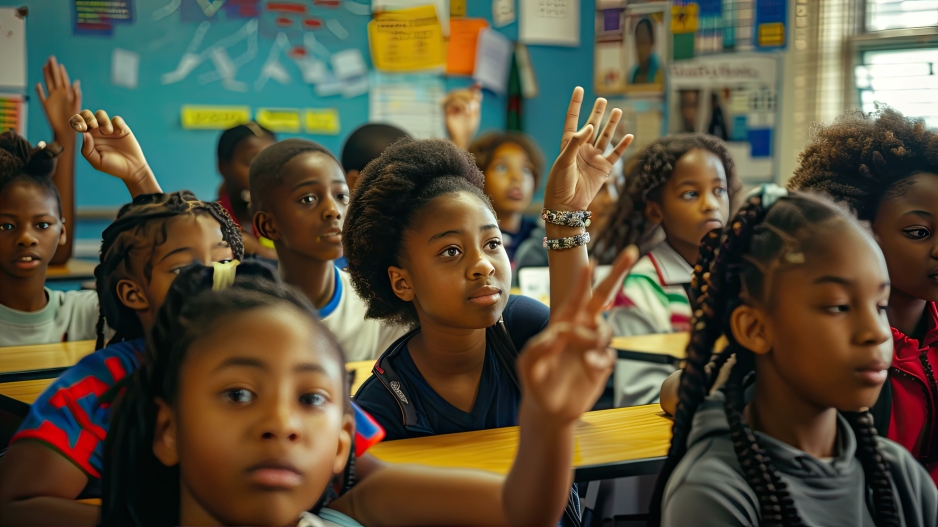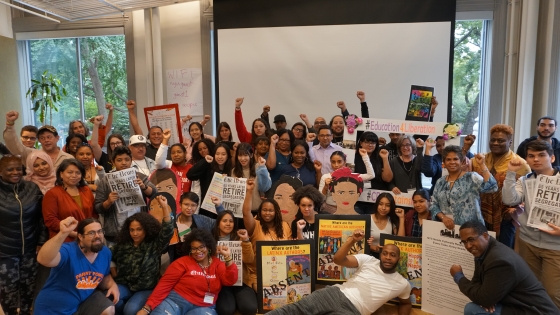
Introduction
For well over a decade, New York City has been at the center of research, debates, innovations, and resolutions all in the name of school integration. Starting in 2012 and reaching a peak in 2015, it became abundantly clear that the movement for integration was no longer a sidelined topic in education reform.(1) From 2015 onwards, The New York City Department of Education (DOE) was investing in integration efforts like never before, and City Hall, while not an enthusiastic supporter, was not actively obstructing processes with integration as a goal. As communities across the nation commemorate the 70th anniversary of Brown v. Board of Education, NYU Metro Center partnered with New York Appleseed to gather the highlighted history, data, and resources that have defined the integration movement in New York City over the past decade. As New York City enters a new chapter in the state of integration, this report provides insight into the policy wins for integration that occurred right before the pandemic, and the subsequent changes that have carried this momentum through an unprecedented time for New York City’s school system and the students and families it serves.
Building Momentum
In 2012, on the eve of the 58th anniversary of Brown v. Board of Education, The New York Times published an article documenting and visualizing the segregation in New York City schools, solidifying the city’s title as one of the most segregated school systems in the country.(2) This pivotal article, amplified by advocacy organizations, began to reinvigorate a movement to address segregation across the city. New York Appleseed took a significant lead, conducting illuminating research on the factors contributing to segregation in elementary and secondary schools, while also providing guidance on the necessary steps to mitigate its consequences throughout NYC’s schools. The subsequent years introduced several major wins for the integration movement including piloting new student assignment strategies aimed at diversity, starting with one school in 2013 which grew to 7 schools by 2015 and now has well over 200 school programs participating. 2015 also marked the adoption of a new law that required annual mandated reporting on diversity-specific data points. By 2015, the success of policy wins and effective advocacy strategies made the topic of school integration impossible for City leadership to ignore.
Between 2017 to the end of 2019, a number of pivotal and inextricably linked policy developments were underway. In 2017, following a policy statement in support of school diversity,(3) the DOE released a diversity plan commissioning a School Diversity Advisory Working Group (SDAG).(4) The SDAG was tasked with analyzing the state of segregation in NYC schools and developing recommendations for integration within two years.(5) Although the development of a task force prevented any meaningful recommendations from being made at that moment, what emerged from the 45-person working group in 2019 became an essential blueprint for how the City could effectively integrate its schools.(6)
The SDAG produced two reports: The Path to Real Integration and Equity for NYC Public Schools and Making the Grade II: New Programs for Better Schools.(7) The first report utilized the 5 R’s of Real Integration,8 a framework created by students at the student-led advocacy group, IntegrateNYC, to understand and address school segregation. In total, 67 recommendations were made in the first report of which 62 were adopted by the DOE,(9) marking a crucial moment in which student voice became a central tenet of DOE policy. The second report, which focused on eliminating the discriminatory admission policies present at the elementary and secondary levels, was met with severe backlash from a small, but vocal, and well connected group of affluent parents, who staunchly defended a status quo that favored those already privileged. They further weaponized their access and privilege to fearmonger several elected officials vying for higher officers into silence or opposition on the second report. The United Federation of Teachers (UFT), an SDAG member, initially balked at the second report, withholding their public support for several of the recommendations likely in fear of backlash and ultimately contributing to the erosion of political and public support.(10)
Local media also contributed to the sensationalization and in many cases, misrepresentation of the SDAG’s recommendations, further feeding into a divisive, misinformed narrative. Unfortunately, Mayor de Blasio, who was also launching a longshot bid for the White House, did not have the political courage to provide the leadership needed in this moment of turmoil, and responded to SDAG II with silence.(11) For many advocates, the accompanied silence from the former “Tale of Two Cities” mayor was a clear demonstration of cowardice to change the status quo and poor leadership to turn the courageous conversations he gladly took credit for into courageous and implementable policy.
At the same time the SDAG was hard at work, in 2018, after years of advocacy by District 15 Parents for Middle School Equity and then-Councilmember Brad Lander, the DOE agreed to sponsor a community engagement process to address segregation within Community School District 15 (D15).(12) The outcome of this process led to an unprecedented decision to eliminate middle-school screens across the district.(13) The elimination of the absurd practice of determining a student’s ability to attend a public middle school based on their educational attainment in the first 9 years of their life, led to overnight change. Eight of the eleven middle schools met their targets for diversity, rather than the prior year when only three met set goals.(14)
Both initiatives, the locally driven District 15 Plan and the SDAG saw initial success and continue to be uplifted by advocates as blueprints to what diversity planning can and should look like at district and city levels.(15) Progression of the recommendations from both plans varies, often dependent on leadership’s investments in their continued implementation. For SDAG adopted goals, this report decided to take a closer look into progress—or lack thereof—made.
SDAG Goals: Tracking Progress And Addressing Unknowns
Of the two reports produced by the SDAG, a total of nearly 100 policy recommendations were proposed to address the persistence of segregation in New York City Schools. The first report outlined 67 recommendations, including goals, metrics, and a comprehensive set of policies to meet the conditions for achieving integrated and inclusive schools and classrooms. The second report included about 30 policies meant to provide the “teeth’’ needed to desegregate NYC schools.
As recommendations were organized according to the holistic 5 Rs of Real Integration framework, responsibility of implementation cuts across dozens of DOE offices. SDAG goals, first and foremost, are also publicly available recommendations, with 62 of the adopted 67 recommendations listed on the DOE website. To track progress of the 62 adopted recommendations and also evaluate transparency, New York Appleseed and NYU Metro Center initiated a fact-finding search to gauge progress. Our team employed various methods, including analyzing ongoing or past relationships with DOE offices, reviewing public websites and databases like the School Diversity Accountability Reports, and conducting meetings with coalition partners involved in DOE equity-related initiatives. Tables 1, 2, and 3 in the appendix offer a detailed breakdown of each policy recommendation and its estimated status.
In analyzing overall progress the following patterns and key insights come to light: There is a clear lack of central leadership and intention by the current administration to fulfill outlined goals on a citywide scale and in the name of specifically integrating schools;
Despite this, more than half of the adopted goals are “in progress” or “complete,” often due to smaller initiatives and/or programming led by bureaucrats, school leaders, or even communities committed to educational equity and integration.
Of the goals marked as in progress or complete, many have not advanced past the bare minimum of fulfilling their purpose, with some in peril of being reversed.
Many goals marked as “in progress” are likely intended for continuous advancement and would benefit from monitoring, rather than being marked as completed and set aside
.Since their adoption in 2019, SDAG I goals have not been revisited or acknowledged by the Adams administration. Many of the goals would benefit from an annual revision and monitoring by the New York City Council.
Despite inconsistent and uncoordinated implementation efforts, the SDAG reports and recommendations continue to provide a critical blueprint for building equitably integrated schools. Despite the Adams administration largely ignoring or undermining these recommendations, endeavors to establish integrated schools persist. Progress will remain sluggish until decisive and unwavering leadership becomes imperative to upholding the promise of Brown for the nearly one million students in New York City.
References
- N.R. Kleinfeld, ‘Why Don’t We Have Any White Kids?’, N.Y. Times (N.Y. ), May 11, 2012
- Ford Fessenden, “A Portrait of Segregation in New York City’s Schools,” N.Y. Times, May 11, 2012
- NYC Department of Education, Equity and Excellence for All: Diversity in New York City Public Schools, 2, https://
www.schools.nyc.gov/docs/default-source/default-document-library/diversity-in-new-york-city-public-schools-english
(June 6, 2017) - Id. at 4
- Id. at 5
- School Diversity Advisory Group, Making the Grade : A Path to Real Integration and Equity for NYC Public School Students, https://cdn.givingcompass.org/wp-content/uploads/2019/02/22123200/1c478c_4de7a85cae-
884c53a8d48750e0858172.pdf (Feb. 7, 2019); School Diversity Advisory Group, Making the Grade II: New Programs for Better Schools, https://docs.wixstatic.com/ugd/1c478c_1d5659bd05494f6d8cb2bbf03fcc95dd.pdf (Aug. 26, 2019) - Group, supra
- Integrate NYC, Real Integration (2020), https://integratenyc.org/mission
- Office of the Mayor, Mayor de Blasio, Schools Chancellor Carranza Announce Adoption of School Diversity Advisory Group Recommendations, https://www1.nyc.gov/office-of-the-mayor/news/292-19/mayor-de-blasio-schools-chancel-lor-carranza-adoption-school-diversity-advisory-group ( June 10, 2019)
- Kirsten John Foy and Michael Mulgrew, Expand gifted and talented education: A proposal to scrap it would
take city schoolchildren in exactly the wrong direction, NY Daily News (Nov. 19, 2019), https://www.nydailynews.com/2019/11/19/expand-gifted-and-talented-education-a-proposal-to-scrap-it-would-take-city-schoolchildren-in-exactly-the-wrong-direction/ - Ethan Geringer-Sameth, Pandemic Reinforces de Blasio’s Inaction on School Desegregation Recommendations, Gotham Gazette (May 22, 2020), https://www.gothamgazette.com/city/9409-pandemic-reinforces-de-blasio-in action-school-desegregation-recommendations
- D15 Diversity Plan, http://d15diversityplan.com/ (Sept. 20, 2018)
- D15 Diversity Plan: Final Report 2018, < 8-9 >, http://d15diversityplan.com/wp-content/uploads/2019/06/190620_
D15DiversityPlan_FinalReport.pdf (last updated Aug. 3, 2018) - Brad Lander, Nyah Berg & David Tipson, The White Flight That Wasn’t: New Data Reveal That Brooklyn School Integration Is Working, https://www.nydailynews.com/opinion/ny-oped-new-data-reveal-brooklyn-school-integra-
tion-is-working-20191114-ygw2flcqkngqne5ctz2ewfu3qy-story.html (last updated Nov. 14, 2019) - Id.

